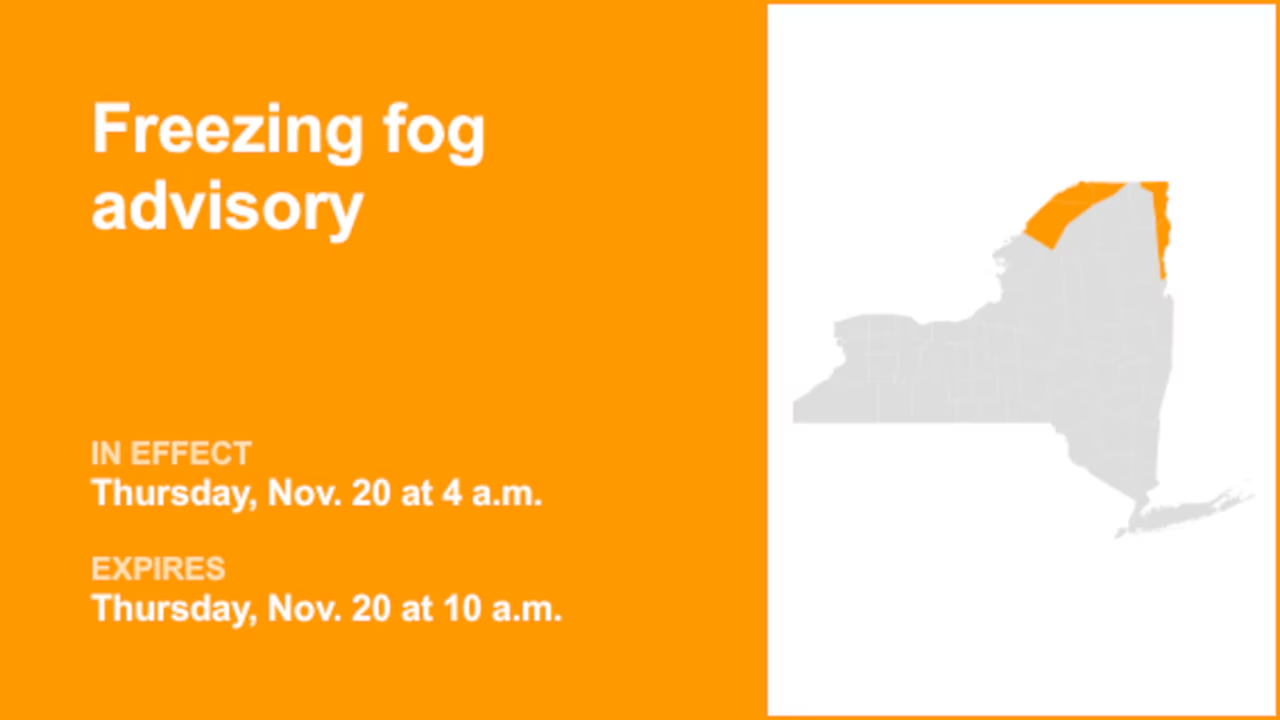Freezing fog advisory issued for North Country until Thursday morning – visibility down to 1/4 mile

At 3:41 a.m. on Thursday, the National Weather Service released a freezing fog advisory valid between 4 a.m. and 10 a.m. for Northern St. Lawrence, Northern Franklin, Eastern Clinton, Eastern Essex and Southwestern St. Lawrence.
The weather service states to be ready for, “Visibility as low as a quarter mile in freezing fog.”
“Low visibility and a light glaze of ice, especially on bridges and overpasses, could make driving conditions hazardous,” adds the weather service. “If driving, slow down, use your headlights, and leave plenty of distance ahead of you.”
Freezing fog advisories: What they signal and why they matter
When a freezing fog advisory is in effect, it indicates that fog is developing while surface temperatures hover at or dip below the freezing point. In such conditions, the minuscule liquid droplets within the fog can instantaneously freeze upon contact with various surfaces, including vehicles and roadways. Freezing fog poses heightened risks for driving, boating, flying, and other modes of transportation. Typically, visibilities plummet to a mile or less.
What is a freezing fog?
Freezing fog, a close cousin to ice, forms the same way as regular fog. Both fog and freezing fog start when the skies are clear, heat radiates into space, and as a result, the Earth’s surface cools down. As this cooling progresses, the air’s capacity to retain moisture decreases, triggering the condensation of water vapor into minuscule liquid droplets — the essential components of fog. When this fog forms in sub-zero temperatures, its water droplets remain in liquid form, a phenomenon known as “Supercooling”. In essence, supercooling occurs when a liquid, despite being below its freezing point, remains in a liquid state due to the absence of a freezing surface.
When these supercooled droplets encounter surfaces, they undergo a remarkable transformation, crystallizing into delicate ice structures known as rime. This transformation is often visible on vertical surfaces exposed to prevailing winds, as well as on trees, plants, and other elements in the environment. In fact, rime can form on a variety of surfaces, including stairs, railings, sidewalks, roads, and even vehicles.
What is black ice?
Black ice, also known as clear ice, refers to a delicate, nearly invisible layer of glaze ice that forms on various surfaces, especially on roadways. Despite its name, the ice is not black, but possesses exceptional transparency, enabling the underlying black pavement of the road, to remain visible.
The formation of black ice is frequently attributed to freezing fog, which can swiftly coat roadways with this treacherous hazard. Its near-invisibility renders black ice exceptionally perilous, as it poses a significant challenge for road users to detect.
How to stay safe?
When freezing fog blankets your surroundings, the safest course of action may entail avoiding travel if at all possible. If venturing out becomes an inevitability, exercise utmost caution and heed these essential safety guidelines:
High vigilance:
Be vigilant, as freezing fog can give rise to the notorious black ice, which remains elusive and challenging to spot.
Moderate your speed:
Drive at a reduced pace, especially when icy conditions are suspected.
Visibility priority:
Ensure your vehicle is visible to others by using low-beam headlights, which also activate your taillights. If you have fog lights, use them.
Avoid high-beams:
Refrain from using high-beam lights, as they create glare, making it more difficult for you to see what’s ahead of you on the road.
Keep a safe distance:
Maintain a significant following distance to account for abrupt stops or shifts in traffic patterns.
Stay in your lane:
Use the road’s lane markings as a guide to remaining in the correct lane.
For those taking to the skies, remember that even a thin layer of ice can form on aircraft surfaces, posing severe risks to flight safety. Ensure that the aircraft is properly treated or equipped with effective de-icing systems before embarking on your journey.
In the realm of freezing fog, knowledge, and vigilance serve as your steadfast allies, empowering you to navigate these meteorological complexities with safety as your main priority.
If you purchase a product or register for an account through a link on our site, we may receive compensation. By using this site, you consent to our User Agreement and agree that your clicks, interactions, and personal information may be collected, recorded, and/or stored by us and social media and other third-party partners in accordance with our Privacy Policy.





